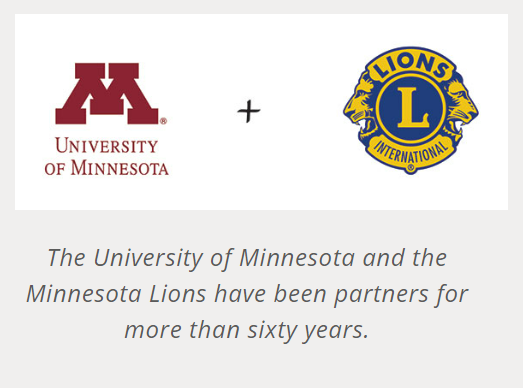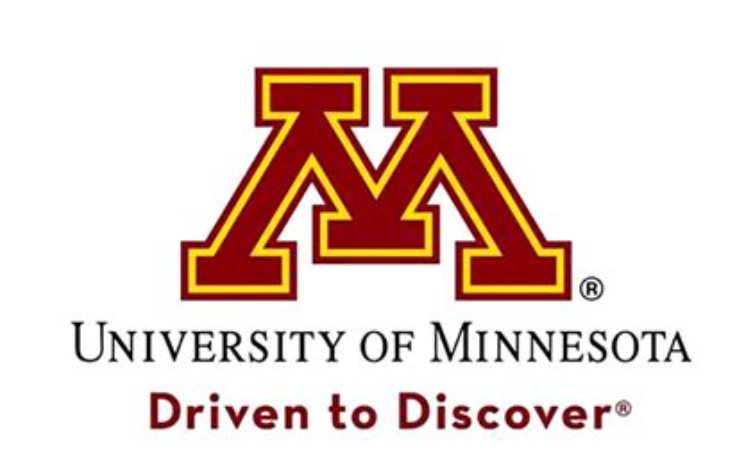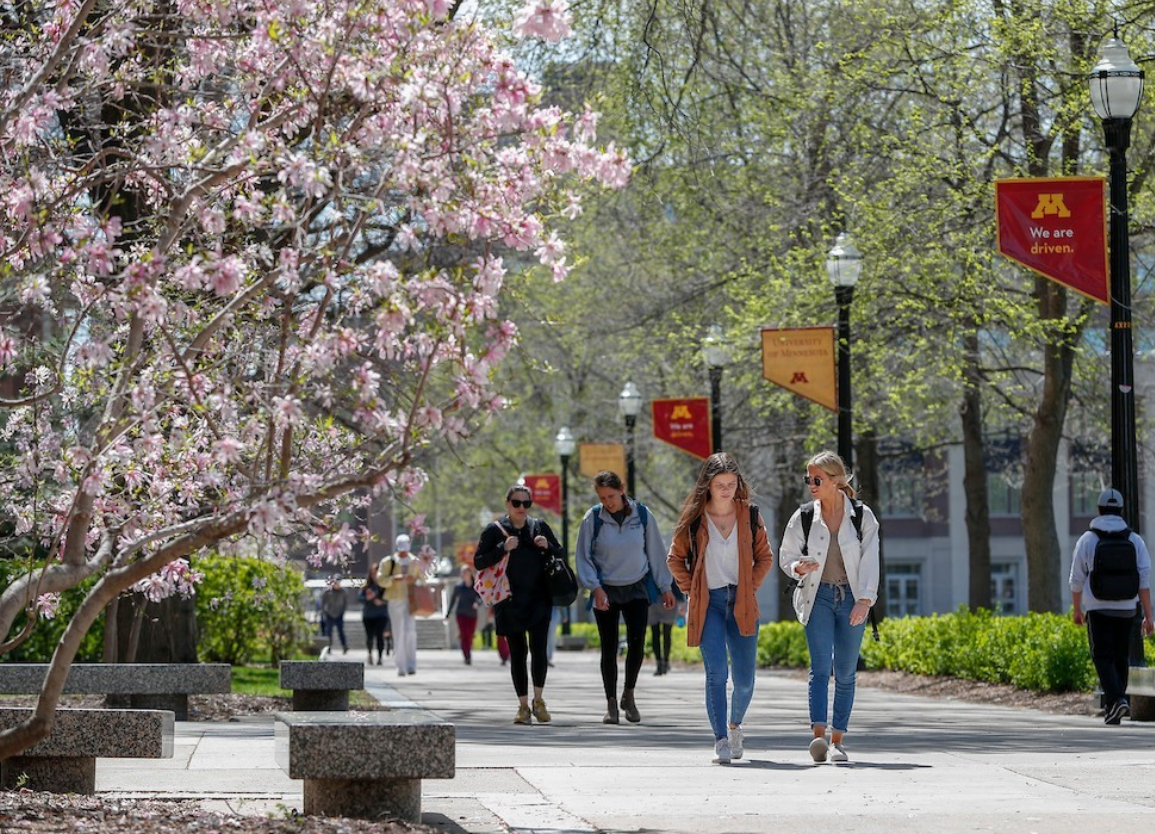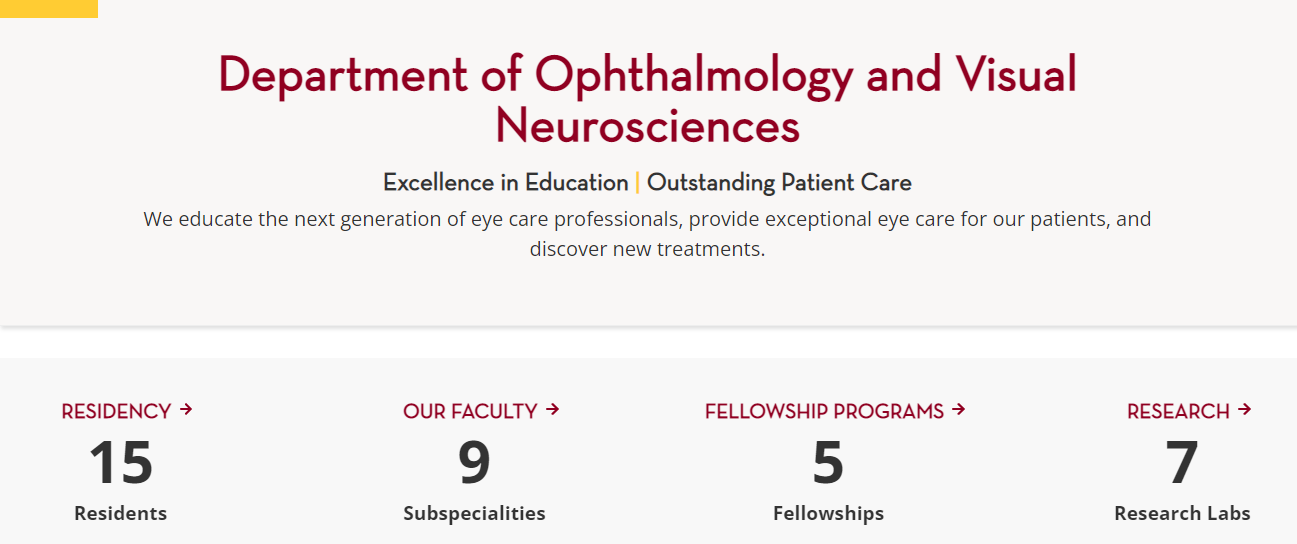Chair, Department of Ophthalmology & Visual Neurosciences (OVNS)
The University of Minnesota Medical School invites applications for the Chair, Department of Ophthalmology and Visual Neurosciences (OVNS).
- Position:
- Chair, Department of Ophthalmology & Visual Neurosciences (OVNS)
- Specialty:
- Neuroscience, Neuroscience, Opthalmology, Leadership, Neuroscientist, Leadership – Department Chair, Ophthalmology, Ophthalmology – Vitreoretinal Surgery, Ophthalmology – Retina, Clinical Trials, Clinical Research, Neuroscience
- Location:
- Minneapolis/St. Paul, MN

Position Overview – Ophthalmology Department Chair
The University of Minnesota Medical School is seeking a highly qualified and experienced academic leader to serve as Professor & Chair of the Department of Ophthalmology & Visual Neurosciences. This is a full-time tenured position and the successful candidate will be appointed at the rank of Associate Professor or Full Professor.
The Department of Ophthalmology & Visual Neurosciences at the University of Minnesota Medical School is a dynamic and growing department that is dedicated to advancing the understanding and treatment of eye diseases and visual disorders. The department is comprised of a diverse group of faculty members who are engaged in cutting-edge research, innovative clinical care, and comprehensive education and training programs.
Role
Professor & Chair, Department of Ophthalmology & Visual Neurosciences
Reporting to
Dean, Medical School
Location
Minneapolis/St.Paul, Minnesota
Key Responsibilities
- Provide visionary leadership to the Department of Ophthalmology & Visual Neurosciences, advancing its mission of excellence in patient care, research, and education.
- Develop and implement strategic plans and initiatives that align with the mission and goals of the department, the medical school, and the university.
- Foster a collaborative and inclusive culture within the department, promoting the growth and development of faculty, staff, and trainees.
- Oversee and manage the academic and administrative functions of the department, including budgeting, resource allocation, and personnel management.
- Develop and maintain strong relationships with other departments, centers, and institutes within the university, as well as with external partners and stakeholders in the community.
- Engage in active research and scholarship in the field of ophthalmology and visual neurosciences, and contribute to the advancement of knowledge in the field through publications, presentations, and other scholarly activities.
- Teach and mentor students, residents, fellows, and other trainees, promoting the highest standards of professionalism, ethical conduct, and clinical excellence.
Qualifications
- MD or MD/PhD degree from an accredited institution.
- Board certification in Ophthalmology.
- Eligibility for licensure in the state of Minnesota.
- Demonstrated excellence in academic leadership, including experience in strategic planning, team building, and personnel management.
- An outstanding record of research and scholarship in the field of ophthalmology and visual neurosciences, as evidenced by publications in high-quality, peer-reviewed journals and presentations at national and international conferences.
- Demonstrated commitment to excellence in clinical care, patient safety, and quality improvement.
- Strong communication, interpersonal, and collaboration skills, with a commitment to fostering a diverse and inclusive environment.
How To Apply
The University of Minnesota Medical School has retained the services of Academic Med to assist with this strategically important leadership search. The search will be led by Gentry Zacheis, Managing Principal for Academic Med. Please direct any initial inquiries, nominations or applications to Mr. Zacheis via email, gentry@academic-med.com.
For more information on the Department of Ophthalmology & Visual Neurosciences (OVNS) please visit the department’s website.
EEO/AA
The University of Minnesota Medical School is an Equal Employment Opportunity/Affirmative Action institution committed to excellence through diversity. UMN will not discriminate based upon race, ethnicity, color, sex, religion, national origin, age, disability, genetic information, sexual orientation, gender identity or expression, pregnancy, marital status, military or veteran status, or any other status or classification protected by federal, state, or local law. All eligible candidates are encouraged to apply including veterans and individuals with disabilities.
Department of Ophthalmology & Visual Neurosciences (OVNS)
About
At the Department of Ophthalmology and Visual Neurosciences at the University of Minnesota Medical School, we educate the next generation of eye care professionals, provide exceptional eye care for our patients, and discover new treatments.
Education & Training
Our residents, fellows, and students train with faculty across specialties and gain hands-on experience with a wide variety of patients with diverse eye problems. We also offer continuing medical education through grand rounds.
Ophthalmology Residency: A four-year, clinically-oriented training program. Residents will be eligible to take the examination for board certification by the American Board of Ophthalmology.
Post-residency Fellowships: Continued training in pediatric ophthalmology, oculoplastic and orbital surgery, neuro-ophthalmology, retina, and anterior segment.
Orthoptic Program: Two-year program with didactic coursework and clinical work at University of Minnesota hospitals and clinics.
Research
Our clinical researchers and basic science researchers collaborate together, working in state-of-the-art laboratories and facilities. This leads to notable discoveries from the laboratory into the clinic in areas such as macular degeneration, cornea transplantation, and oculoplastics. Our research achievements include:
- Developed the solution, now used worldwide, that preserves corneal tissue for transplant
- Created a system to rate the severity of macular degeneration research tissue
- Improved outcomes for pediatric corneal transplants
Patient Care
Get the best care possible. Each year our physicians provide care for approximately 71,000 patients, for adults and children, in all six subspecialty areas of ophthalmology:
- cornea and refractive surgery
- glaucoma
- neuro-ophthalmology
- ophthalmic plastic and reconstructive surgery
- pediatric ophthalmology and strabismus
- vitreoretinal diseases.
Department Website
For more information on the Department of Ophthalmology & Visual Neurosciences (OVNS) please visit the department’s website.

Lions Gift of Sight
The partnership between the Lions and the Department of Ophthalmology & Visual Neurosciences came to life in 1960 with the establishment of Lions Gift of Sight. This partnership has grown greatly over the decades since then and today encompasses:
The eye bank provides donor eye tissue for transplant, research, and teaching, and promotes donation through education. Lions Gift of Sight has helped restore sight to more than 39,000 people by providing cornea tissue for transplantation and is one of the largest and most successful eye banks in the world. In addition, they’ve provided more than 36,000 corneas or eyes for basic research to help advance vision science.
Minnesota Lions Children’s Eye Clinic
More than 5,000 children receive care every year. The clinic is one of the largest and best-staffed clinics of its kind in the country.

Lions Research Building
Provides nearly 12,000 square feet of research space and services for an immunology laboratory, extraocular and facial muscle laboratory, optic nerve rescue laboratory, corneal dystrophy laboratory, and three laboratories working on aspects of macular degeneration.
William H. Knobloch Retina Chair
Supports research and treatment of retina disease.
Lions Macular Degeneration Center
Known as “The MAC Center,” is an internationally recognized leader in research and clinical care. Equally important, the Lions Gift of Sight has been instrumental in rallying community support for vision issues and contributing countless hours of volunteer time throughout the state.
Minnesota Lions Fund to Prevent Blindness in Infants and Children
Created in 2010, the Fund will ensure that the finest eye care for infants and children can be delivered by our entire faculty, that newer and better ways will be found to prevent and treat vision-threatening disease, and that greater information and education will become available to eye care providers and the community.
Minnesota Lions Eye Surgery Center
In March 2015, the Minnesota Lions Vision Foundation pledged to raise $4 million to establish the Minnesota Lions Eye Surgery Center. This gift will make it possible for University of Minnesota eye surgeons to perform common surgeries, including sight-saving cornea, glaucoma, retina, and cataract surgeries on the U of M campus. The Lions Eye Surgery Center is the first step toward the wished for Lions Eye Institut
Minnesota Lions Vision Foundation
The Lions Sight Program is supported by the Minnesota Lions Vision Foundation, Inc. The Vision Foundation funds the operating expenses of Lions Gift of Sight, their first and largest endeavor, and provides a board of directors that gives fiscal oversight to the eye bank. The Foundation partners with the Lions of Minnesota, Lions Gift of Sight, and the University of Minnesota to increase public awareness about eye donation. In addition to their work with the eye bank, the non-profit foundation aids in funding research projects and equipment for University of Minnesota vision programs and fosters, advances, and promotes vision-related scientific, educational, or charitable aims and projects of other individuals or associations. The Foundation also facilitates used eyeglass recycling in Minnesota.

The University of Minnesota
The University of Minnesota is a top-tier research institution located in Minneapolis-St. Paul, with a long-standing reputation for academic excellence and innovation. With more than 50,000 students, it is one of the largest universities in the United States, offering a wide range of undergraduate and graduate programs across a diverse array of fields. The university boasts a high graduation rate and a strong commitment to research, with over $1 billion in research expenditures each year. It is also recognized for its affordability, with tuition rates that are lower than many comparable universities.
The University of Minnesota is home to numerous renowned faculty members, including Nobel laureates and MacArthur fellows, and is committed to creating a welcoming and inclusive community for all students, faculty, and staff. Overall, the University of Minnesota is a leading institution of higher education that offers a world-class education, cutting-edge research opportunities, and a commitment to fostering an inclusive and diverse community.

UMN Clinical & Translational Science Institute (CTSI)
The Clinical and Translational Science Institute (CTSI) at the University of Minnesota is enhancing the way research is conducted to make a meaningful impact on people’s lives. Our mission: Accelerate discoveries toward better health.
CTSI is part of the prestigious Clinical and Translational Science Award (CTSA) program, which aims to get interventions to patients and populations more quickly and enable research teams to tackle system-wide problems in clinical and translational research.

University of Minnesota Medical School
The University of Minnesota Medical School is the medical school of the University of Minnesota. It is a combination of two campuses situated in Minneapolis and Duluth, Minnesota. The University of Minnesota Medical School is also part of one of the largest Academic Health Centers (AHC) in the United States. This center allows health professionals to train collaboratively across interdisciplinary teams throughout the course of their training programs. The AHC comprises the Medical School, School of Dentistry, School of Nursing, College of Pharmacy, School of Public Health, and the College of Veterinary Medicine.
Founded in 1888, the University of Minnesota Medical School educates students and graduate physicians, provides patient care, and performs biomedical and clinical research. We offer medical, graduate and undergraduate degree programs, as well as continuing professional development. Our Medical School is one of the largest in the country, with two campuses based in the Twin Cities and Duluth, Minnesota. The Twin Cities campus is an interdisciplinary research center. Our Duluth campus educates 130 first and second-year medical students committed to practicing in rural or American Indian communities. The Mission of the University of Minnesota Medical School is to be a leader in enhancing the health of people through the education of skilled, compassionate and socially responsible physicians. With two campuses serving diverse populations in rural and urban Minnesota, the Medical School is dedicated to preeminent primary care medicine, exemplary specialty care and innovative research.

Minneapolis – Saint Paul, Minnesota
The Minneapolis-Saint Paul area is cosmopolitan at its heart and small towns along its perimeter. The Twin Cities is the 16th largest metro area in the US, with a population of approximately 3.4 million people. It is the 2nd largest economic center in the Midwest, behind Chicago, and the second-largest medical device manufacturing center in North America.
Fortune 500 Companies in MSP
Minneapolis proper contains the 5th highest concentration of Fortune 500 companies in the country. The presence of the corporate headquarters for companies such as Target, US Bancorp, Xcel Energy and Ameriprise Financial provide a growing economy with great job opportunities for a candidate’s spouse or family.
Additionally, an exciting arts and music scene, exceptional shopping, award-winning restaurants, wineries and craft breweries, and distinctive accommodations can be found throughout the area. Outdoor enthusiasts find plenty to do – even when temperatures dip, the variety of fun outdoor adventures does not. Sports fans cheer on their favorite team year-round. Big city bustle or small-town charm, anyone can find the activity that suits them in the Minneapolis – Saint Paul Area.
Minneapolis-St. Paul is a metropolitan area in the heart of the Midwest, and the largest city in the state of Minnesota. It offers a high quality of life, excellent public schools, and a strong economy, consistently ranking as one of the best places to live in the United States. The area boasts a thriving arts and culture scene, with world-class museums, theaters, and music venues, as well as extensive park systems, lakes, and trails for outdoor enthusiasts.
Hub for Medical Innovation & Research
Minneapolis-St. Paul is recognized as a hub for medical innovation and research, with numerous healthcare organizations, including the world-renowned University of Minnesota Medical School, located in the region. Despite its many amenities, the area has a relatively low cost of living compared to other major metropolitan areas in the United States.
Twin Cities – a Rich History
The Twin Cities also have a rich history of diversity and inclusion, and the University of Minnesota is committed to fostering a welcoming and inclusive community. Additionally, Minneapolis-St. Paul has a well-developed transportation system, including a light rail system, bus network, and extensive bike paths, making it easy to get around without a car. Overall, Minneapolis-St. Paul offers a unique blend of urban sophistication, natural beauty, and cultural diversity that make it an attractive location for professionals in a variety of fields, including medicine and healthcare.
Relevant Links
Interested in exploring roles similar to this Ophthalmology Department Chair opportunity? Learn about some of the other exciting opportunities available at the University of Minnesota Medical School by visiting the job post links below:





